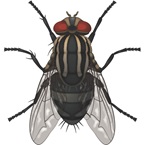Order: Diptera (two-winged)
Family: Muscidae
Common Housefly:
14mm wingspan
CHARACTERISTICS:
Single pair of membranous wings; hindwings modified as halteres; suctorial mouthparts, piercing or nonpiercing; large compound eyes; tarsi, 5-segmented; metamorphosis complete with egg, larval, pupal and adult stages.
SPECIES CHARACTERISTICS:
Common Housefly (Musca domestica)
Adults, 6-8mm long with 13-15mm wingspan; grey thorax with 4 longitudinal dark stripes; basal half of abdomen buff-coloured and occasionally transparent at sides, with central dark band broadening to cover last abdominal segments; at rest, wings are spread; venation shows a sharp upward bend of 4th vein at apical end.
AREAS WHERE FOUND:
Common Houseflies (M. domestica) are ubiquitous insects, with a flight range of at least 8 kilometres (5 miles). They are highly active indoors. In colder climates breeding generally ceases before winter, whereupon the insects overwinter either as pupae or adults. However, in warm environments houseflies remain active and reproduce throughout the year.
IMPORTANCE AS A PEST:
Houseflies can transmit intestinal worms, or their eggs, and are potential vectors of diseases such as dysentery, gastroenteritis, typhoid, cholera and tuberculosis. They will frequent and feed indiscriminately on any liquefiable solid food, which may equally be moist, putrefying material or food stored for human consumption. Flies liquefy food by regurgitating digestive juices and their stomach contents on to the food substance. This ‘liquid’ is then drawn up by the suctorial mouthparts and in so doing the insects pick up pathogenic organisms, which may collect on their bodies to be transferred on contact with other surfaces or survive passage through the gut to be deposited as fly spots. Fly spotting, produced when the insect feeds or defecates, results in rejection of contaminated farm produce, for example eggs, at point of sale. Furthermore, flies are frequently the subject of complaints to environmental health authorities, causing major problems where infestations over-spill from breeding sites such as rubbish tips and animal houses.
LIFE-CYCLE:
If left unchecked a housefly problem can quickly get out of hand. The life cycle goes from egg to adult in just 7-12 days and as many as 10-12 generations can occur in one summer. So, even if just 100-200 of eggs per female fly survive until adult stage, the end result poses a massive fly problem.
Larvae – The larval stage is called maggots. The maggot is white, legless and conical in shape. Maggots have chewing mouthparts, called mandibles. Maggots feed with the ends of their bodies (the part that contains the breathing pores) on the surface of the food whilst their heads are embedded in the food source. In warm weather it may be fully developed in 3 days, reaching 10-12 mm in length, but under less satisfactory conditions it may take 30 days to complete development. When fully fed the maggot appears waxy and ivory–yellow in colour. The maggot leaves the larval environment in search of a cooler and drier place in which to pupate. They may travel considerable distances before finding a suitable spot and readily crawl up a smooth, moist vertical surface.
CONTROL:
Flies have rapid, prolific breeding habits and high mobility. In order to break the life-cycle, control measures should be directed against larval and adult flies.
- Hygiene/management
Satisfactory hygiene is necessary to limit potential breeding sites and food sources.
Domestic refuse: this must be stored in well sealed bins, for early removal to disposal sites. High-risk material should be sealed in bags and burnt wherever possible. Refuse tips should be covered with earth, to a depth of at least 230mm (9 inches), and then compacted. This will minimise adult emergence and promote fermentation temperatures at which larvae cannot survive.
Farm manure: manure should be kept as dry as possible, especially in poultry houses, where leaking water feeders can provide ideal, moist breeding conditions. The Biothermic method of storing dung involves compacting manure into a cuboid stack, a method particularly suited to horse manure.
This form of storage promotes uniform, persistent fermentation throughout the dung, which is lethal to larvae. Tarpaulins can also be used to cover heaps, in order to prevent egg laying and conserve the heat of fermentation. Entry of adult flies into buildings can be prevented by 1.18mm-mesh flyscreens (which can easily be removed for cleaning), air curtains, bead screens or self-closing doors equipped with rubber flaps.
- Physical control using maggot traps:
Maggot traps take advantage of the fact that larvae need to migrate from breeding sites to cooler surroundings in order to pupate. A simple trap consists of a concrete platform, on which manure or refuse is stored, surrounded by a water-filled moat in which migrating larvae are trapped.
- Insecticides:
In order to obtain the best results, insecticidal control measures (see recommended products) should be integrated with good hygiene.
Halteres: Club-shaped balancing organs. Suctorial: Capable of sucking. Tarsus (Tarsi): Apical section of leg (the foot).

